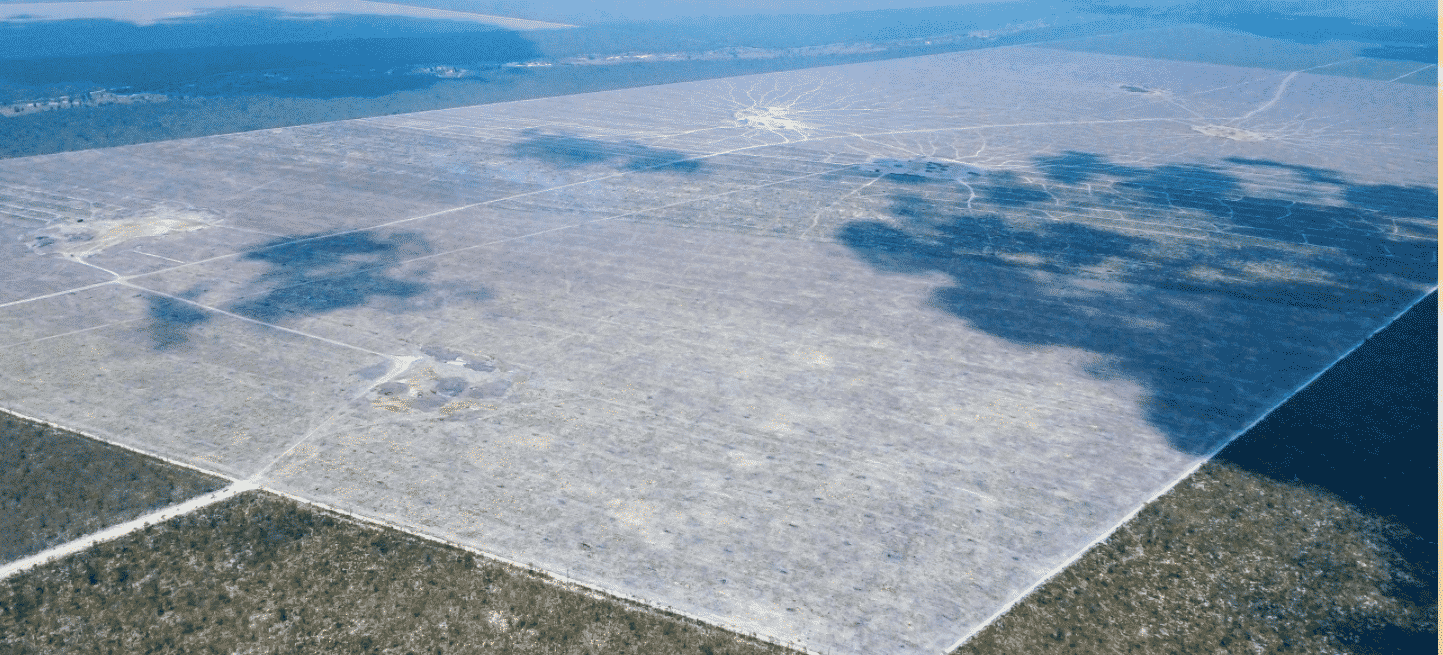 One spectacular global news story catches your eye. Then another. You can’t really get either of them out of your head. But, at first, they form two distinct impressions. Then over the following days you widen your reading by one or two clicks. You go a bit deeper. You see one or two more ramifications. And, suddenly, it is the same story, now even more dizzying in scope.
One spectacular global news story catches your eye. Then another. You can’t really get either of them out of your head. But, at first, they form two distinct impressions. Then over the following days you widen your reading by one or two clicks. You go a bit deeper. You see one or two more ramifications. And, suddenly, it is the same story, now even more dizzying in scope.
But, having grasped the connection another process sets in. The bigger picture loses its startling shock-value. Rather than two disconnected deep impressions you end up with some some familiar, reified generality:
“Sure! Of course! I get it. It’s globalization, the anthropocene, whatever, etc ….”.
But that shoulder shrug is, presumably, what we have to resist. We do, indeed, have labels for all this. Everything is connected and on a massive scale. We know it. That knowledge overshadows our existence. But, as such, it also becomes all too familiar rather than profoundly disconcerting.
What do we have to do to restore the jaw-dropping, eye-popping, stomach-churning quality of our global condition? How can we get its measure? How can we make our knowledge specific, quantified, immediate, historical?
I
This week, the first story was about American agriculture. The farm team at the WSJ’s Plowed Under are excellent and I ended up reading a vaguely Trump-flavored essay by Jesse Newman and Jacob Bunge about American farmers facing global competition.
It starts like this:
“On a pancake-flat stretch of land not far from the Mississippi River, Illinois farmer Jerry Gaffner thumbs through weather forecasts and crop reports on his tablet computer, searching for clues about when to market his soybean crop.
The data streaming in isn’t from Illinois or even the American Midwest. It is from half a world away in Brazil, where farmers are harvesting what’s expected to be a record soybean crop. With 43% of the export market—up from just 12% 30 years ago—Brazil can sway global prices with a weather hiccup or transportation snarl, spurring U.S. farmers to sell crops and capture profits, or to bunker grain and hold off until prices improve.“We’re going to have to learn the table manners of sitting at a bigger table,” says Mr. Gaffner, whose soybeans often make their way down the Mississippi to be shipped overseas from New Orleans ports. For U.S. farmers, he says, “that’s hard for our psyche.”
The piece achieves its effect by juxtaposing the mid-West and Brazil. Gaffner’s counterpart thousands of miles to the South is a certain “Mr. Gilioli, 37” who has “pulled record yields from his 5,000 acres in Brazil’s Goiás state.
“Inside the farm, it looks just like the U.S.,” says Mr. Gilioli, who wears an Iowa State Cyclones hat, Levi’s T-shirt and Wrangler bluejeans. Mr. Gilioli lived on a farm in Iowa for a year as an exchange student and has made four visits to tour farms across the Midwest.”
“Brazil’s agricultural growth-spurt began about four decades ago”, the WSJ tells us. It dates back to the military dictatorship in the 1970s and early 1980s, “as farmers were lured north to its sweeping savanna, known as the cerrado, by the promise of cheap land and climbing soybean demand and prices. The region stretches over 500 million acres, an area three times the size of Texas and nearly 50% bigger than all the land in the U.S. used to grow crops. … Farm operations can dwarf U.S. counterparts in size, including some with multiple parcels that when added up are larger than Yosemite National Park.”
As the WSJ emphasizes, Brazil’s development was not simply a matter of national competition:
“Also part of the silver lining” (from the point of view of the average reader of the WSJ rather than farmer Gaffner) are the returns for American corporations. Brazil’s agricultural growth generates ”booming international revenue for U.S. companies such as Monsanto Co. , Deere & Co. and Mosaic Co. , who sell genetically engineered seeds, satellite-guided tractors and fertilizer to farms outside America. In some cases, U.S. companies design products and seeds specifically for foreign markets.”
Amongst those investing in the giant expansion of Brazilian agriculture is none other than TIAA-CREF, which manages the 401k retirement funds of many American academics. According to a New York Times report:
“TIAA-CREF’s disclosures show that its farmland holdings in Brazil climbed to 633,391 acres at the start of 2015, up from 257,877 acres in 2012, around the time when it began ramping up deals through a venture formed with Cosan, a Brazilian sugar and biofuels giant.”
Now I want to know about this “cerrado”, this vast 500 million acre expanse, which is changing the balance of power in world agricultural markets, that has some of my retirement dollars invested in it.
Googling brings up a story from The Economist back in 2010, a typically informative and ebullient piece titled “The Miracle of the cerrado”. Characteristically for The Economist what was at stake was not just the scale of agricultural development or the pressure it exerts on American farmers. What was remarkable about the cerrado story was where it was happening and the political economy of that transformation.
That the cerrado miracle is happening in places like Gioas state or “Piauí—the Timbuktu of Brazil, a remote, somewhat lawless area where the nearest health clinic is half a day’s journey away and most people live off state welfare payments—is nothing short of miraculous. …. No less astonishingly, Brazil has done all this without much government subsidy. According to the Organisation for Economic Co-operation and Development (OECD), state support accounted for 5.7% of total farm income in Brazil during 2005-07. That compares with 12% in America, 26% for the OECD average and 29% in the European Union. And Brazil has done it without deforesting the Amazon (though that has happened for other reasons). The great expansion of farmland has taken place 1,000km from the jungle.”
As a later Economist piece explains:
“in 1990 Brazil’s then president, Fernando Collor, slashed tariffs and dismantled many import and export controls. Since then the total area under crop cultivation in Brazil has increased by 38% and production has more than trebled. Total factor productivity has been growing by 4.6% a year. “In these new areas [such as MaPiToBa – the states of Maranhão, Tocantins, Piauí and Bahia – that encompass the cerrado] they rarely even mention the government,” says Mr Gasques. “There’s no culture of subsidies; it was broken 20 years ago.”
But the cerrado story is not simply a matter of letting the market rip. This was not neoliberalism 1.0. At least in the The Economist‘s telling of it, Brazil’s agricultural revolution is the triumph of an efficient, low cost public private partnership. Above all the cerrado illustrates the important role played by Brazilian agronomical research.
The story turns around an organization known as Embrapa “short for Empresa Brasileira de Pesquisa Agropecuária, or the Brazilian Agricultural Research Corporation. It is a public company set up in 1973, in an unusual fit of farsightedness by the country’s then ruling generals.” Embrapa’s “main achievement”, the Economist gushes, “has been to turn the cerrado green.”
“When Embrapa started, the cerrado was regarded as unfit for farming. Norman Borlaug, an American plant scientist often called the father of the Green Revolution, told the New York Times that “nobody thought these soils were ever going to be productive.” They seemed too acidic and too poor in nutrients. Embrapa did four things to change that. First, it poured industrial quantities of lime (pulverised limestone or chalk) onto the soil to reduce levels of acidity. In the late 1990s, 14m-16m tonnes of lime were being spread on Brazilian fields each year, rising to 25m tonnes in 2003 and 2004. This amounts to roughly five tonnes of lime a hectare, … Embrapa scientists also bred varieties of rhizobium, a bacterium that helps fix nitrogen in legumes and which works especially well in the soil of the cerrado, reducing the need for fertilisers. Second, Embrapa went to Africa and brought back a grass called brachiaria. Patient crossbreeding created a variety, called braquiarinha in Brazil, which produced 20-25 tonnes of grass feed per hectare, many times what the native cerrado grass produces and three times the yield in Africa. That meant parts of the cerrado could be turned into pasture, making possible the enormous expansion of Brazil’s beef herd. Thirty years ago it took Brazil four years to raise a bull for slaughter. Now the average time is 18-20 months.”
GM-modified grasses, even more luscious than original Brachiaria, are on the way.
“Third, and most important, Embrapa turned soyabeans into a tropical crop. Soyabeans are native to north-east Asia (Japan, the Korean peninsular and north-east China). They are a temperate-climate crop, sensitive to temperature changes and requiring four distinct seasons. All other big soyabean producers (notably America and Argentina) have temperate climates. Brazil itself still grows soya in its temperate southern states. But by old-fashioned crossbreeding, Embrapa worked out how to make it also grow in a tropical climate, on the rolling plains of Mato Grosso state and in Goiás on the baking cerrado. More recently, Brazil has also been importing genetically modified soya seeds and is now the world’s second-largest user of GM after the United States. This year Embrapa won approval for its first GM seed.Embrapa also created varieties of soya that are more tolerant than usual of acid soils (even after the vast application of lime, the cerrado is still somewhat acidic). And it speeded up the plants’ growing period, cutting between eight and 12 weeks off the usual life cycle. These “short cycle” plants have made it possible to grow two crops a year, revolutionising the operation of farms.”
Thanks to Embrapa, Brazil has achieved nothing less than “the genetic transformation of soya”.
“Lastly, Embrapa has pioneered and encouraged new operational farm techniques. Brazilian farmers pioneered “no-till” agriculture, in which the soil is not ploughed nor the crop harvested at ground level. Rather, it is cut high on the stalk and the remains of the plant are left to rot into a mat of organic material. Next year’s crop is then planted directly into the mat, retaining more nutrients in the soil. In 1990 Brazilian farmers used no-till farming for 2.6% of their grains; today it is over 50%.”
The detritus of this no-till farming technique, I suspect, is why pictures from the cultivated cerrado always look so bleak:
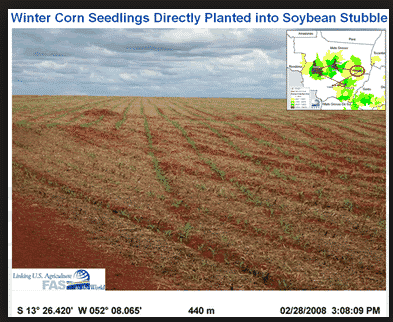
source: https://ipad.fas.usda.gov/highlights/2008/04/Brazil/
The essential point about the Brazilian case from The Economist’s point of view is that it is not simply a story of natural endowments. “So although it is true Brazil has a lot of spare farmland, it did not just have it hanging around, waiting to be ploughed. Embrapa had to create the land, in a sense, or make it fit for farming.”
This echoes key works on modern economic history by Paul David and Gavin Wright (1997). As they famously put it about the ascent of the United States as a mineral exporter after the civil war: ‘natural resource abundance’ is an “endogenous, ‘socially constructed’ condition that was not geologically preordained.” The exploitation of natural resource potential is a function of “complex legal, institutional, technological and organizational adaptations that shaped the US supply-responses to the expanding domestic and international” demand for a particular resource. “Natural resources” are not separable from capital, scientific research, legal structures etc.
In the Brazilian case The Economist in a later article continues the argument.
“The transformation of the cerrado is often dismissed as Brazil’s belated discovery of a competitive advantage. That leaves out a lot, and not just Embrapa’s role and the courage of the gaúcho pioneers. Farming in the tropics is in many ways more difficult than in a temperate climate. Without cold winters, pests and crop diseases are harder to control. Intensive soil preparation and large amounts of lime and fertiliser require scale and capital. According to Rodrigo Rodrigues of Agrifirma, a company that buys and farms virgin cerrado, preparing land for its first crop—deep-tilling, root-picking, liming and so on—means passing over it 15 times, which costs as much as the land itself.”
The result is an economic miracle and a political transformation. Brazil’s hot house industries may depend on endless protection to shield them against worldwide competition. But its farmers are different.
“Unlike their counterparts in the United States and the European Union, farmers are now Brazil’s most ardent proponents of free trade. They want an EU-Mercosur deal, which has been mooted for years and is becoming urgent for Brazil, since from next year it will be rich enough to lose its trade preferences. Bahian farmers want to cattle-ranch on cerrado that has too little rain for crop-farming, but for that to be profitable they need new markets. “We’d love to sell to Europe,” says Mr Busato. “Their meat is so expensive.””
And this is not all. For The Economist the “cerrado miracle” is not just about getting market-based political economy right. It is not just about solidifying the political base of globalization. It is nothing less than the swing variable in the global food balance. It is, as such, also the answer to the Malthusian challenge of the 21st-century. It is a story not so much about Iowa as about Africa.
“Between now and 2050 the world’s population will rise from 7 billion to 9 billion. Its income is likely to rise by more than that and the total urban population will roughly double, changing diets as well as overall demand because city dwellers tend to eat more meat. The UN’s Food and Agriculture Organisation (FAO) reckons grain output will have to rise by around half but meat output will have to double by 2050. This will be hard to achieve because, in the past decade, the growth in agricultural yields has stalled and water has become a greater constraint. By one estimate, only 40% of the increase in world grain output now comes from rises in yields and 60% comes from taking more land under cultivation. In the 1960s just a quarter came from more land and three-quarters came from higher yields.So if you were asked to describe the sort of food producer that will matter most in the next 40 years, you would probably say something like this: one that has boosted output a lot and looks capable of continuing to do so; one with land and water in reserve; one able to sustain a large cattle herd (it does not necessarily have to be efficient, but capable of improvement); one that is productive without massive state subsidies; and maybe one with lots of savannah, since the biggest single agricultural failure in the world during past decades has been tropical Africa, and anything that might help Africans grow more food would be especially valuable. In other words, you would describe Brazil.”
This was image number one: the dynamic development of a huge swath of the planet to meet massive population pressure; the cerrada as one of the keys to the human condition in the early twenty-first century.
II
A few days later the Guardian feed highlighted a spectacular story on environmental change. An astonishing new report on zones of martime deoxygenation had just been published in Science.
The pictures are horrifying. The data are graphic.
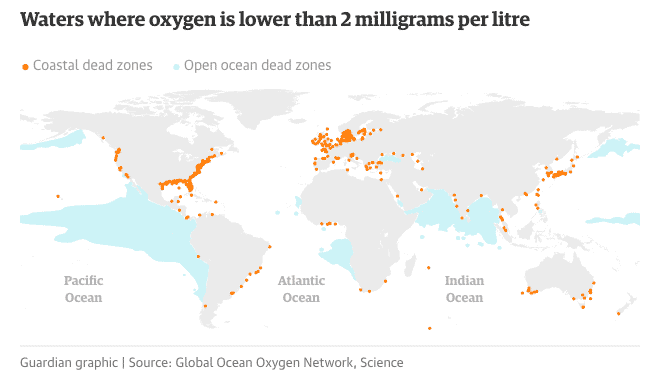
For laconic apocalypticism this paragraph from the Science paper takes some beating:
“The open ocean lost an estimated 2%, or 4.8 ± 2.1 petamoles (77 billion metric tons), of its oxygen over the past 50 years (9). Open-ocean oxygen-minimum zones (OMZs) have expanded by an area about the size of the European Union (4.5 million km2, based on water with <70 μmol kg−1 oxygen at 200 m of depth) (10), and the volume of water completely devoid of oxygen (anoxic) has more than quadrupled over the same period (9). Upwelling of oxygen-depleted water has intensified in severity and duration along some coasts, with serious biological consequences (11).”
As The Guardian explains: “The open ocean has natural low oxygen areas, usually off the west coast of continents due to the way the rotation of the Earth affects ocean currents. But these dead zones have expanded dramatically … .”
The Science piece outlines a truly nightmarish run away process in which climate change induces declining oxygen levels, encouraging biological changes that then pump out even more dangerous climate change gases at ever faster rates. As the Guardian puts it: “There are also dangerous feedback mechanisms. Microbes that proliferate at very low oxygen levels produce lots of nitrous oxide, a greenhouse gas that is 300 times more potent than carbon dioxide.” Skimming the Science paper I wonder, did the Guardian get this right? Is it microbes or “biogeochemical” (sic) processes of nitrification and denitfrication? Either way it sounds terrifying.
In fact, it is a three-tiered story. There are the deep sea oceanic processes and then there are the costal strips. The Science paper highlights the Baltic sea. But, bringing it home to the US the Guardian picked out the huge zone of oxygen depletion is the Gulf of Mexico. Dead zones in the gulf have recently been a regular occurrence. But the summer of 2017 witnessed the most massive dead zone since records began.
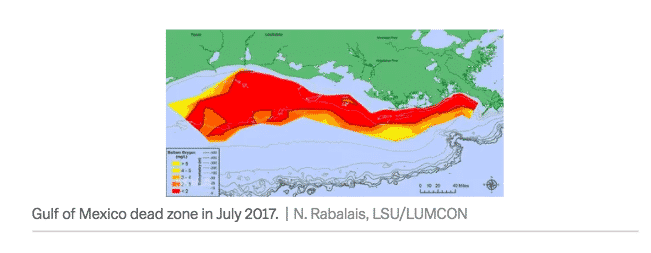
This takes the Guardian to the third level of the story.
The collapse of oxygen levels in the Gulf of Mexico turns out to be a story about the Mississippi. It is nitrogen and phosphates flowing down America’s greatest river system that tip the chemical balance of the Gulf.
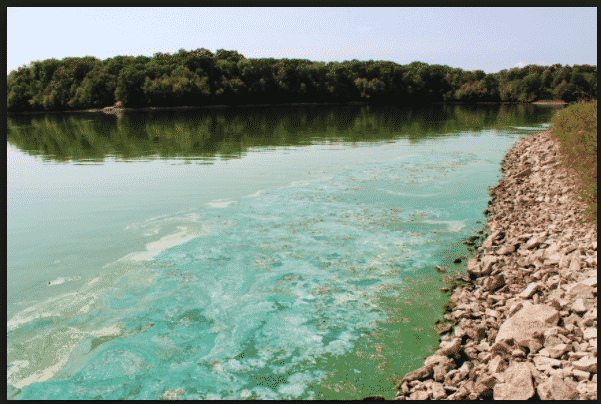
It is an ongoing disaster. More nitrogen pollution flows into the Gulf every year than tonnage of oil was released by the BP Deepwater Horizon disaster.
And what is responsible for these gigantic nitrogen and phosphorous run offs? Not the oil and gas industry in the Gulf, but Midwestern agriculture, far up stream, in places just like the one where this skein of connections began. Remember where the WSJ piece opened, on a: “a pancake-flat stretch of land not far from the Mississippi River” where Illinois farmer Jerry Gaffner is anxiously watching weather reports from Brazil.
III
The Guardian piece linked to a fascinating looking report on the US agro-industrial complex. Click bait as far as I am concerned. So, it was not long before I found myself plowing through a beautifully illustrated, richly sourced report on nitrogen pollution in the mid west, by an outfit called “Mighty Earth”.
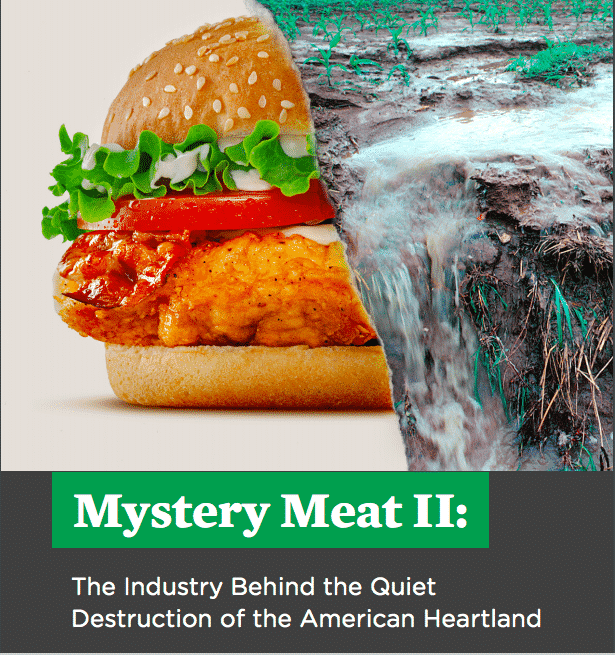
The scales of pollution are massive. They are driven by the high intensity agro-industrial complex centered on Tyson the giant meat producer and its feed suppliers. Together livestock farming and the agriculture is depends on, create what the report eerily calls, “landscapes of feed”.
Their political economy is stark. It is a gigantic US-based but globally extended oligopoly. Tyson, and the gigantic grain and commodity processors ADM, Cargill and Bunge are the main players. Setting the terms for local farmers this agro-industrial complex creates a large expanse of the US where the water is undrinkable due to excessive nitrate concentrations. What doesn’t seep into the local water supply, is what washes down to the rivers to the Gulf.
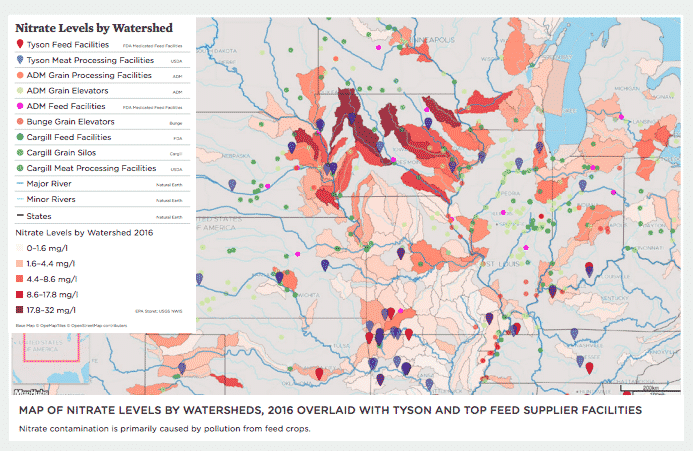
The people who supply this conglomerate system are, of course, people like Mr Gaffner who was interviewed by the Wall Street Journal. And they are struggling to compete and meet the demands of the system by bringing as much land as possible into production. The result over the last decade has been a remarkable destruction of one of America’s last great habitats, the prairie grasslands. More rapidly than at any time since the dustbowl era, American grassland have been brought into agricultural production.
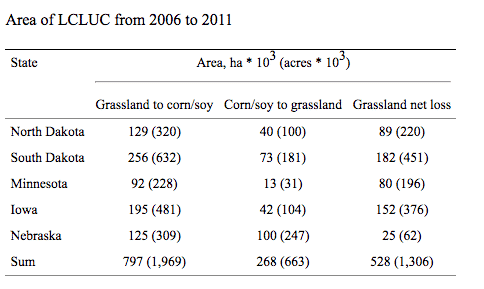
As the authors of a recent PNAS paper put it:
“Our results show that rates of grassland conversion to corn/soy (1.0–5.4% annually) across a significant portion of the US Western Corn Belt (WCB) are comparable to deforestation rates in Brazil, Malaysia, and Indonesia, countries in which tropical forests were the principal sources of new agricultural land, globally, during the 1980s and 1990s. Historically, comparable grassland conversion rates have not been seen in the Corn Belt since the 1920s and 1930s, the era of rapid mechanization of US agriculture. Across the WCB, more than 99% of presettlement tallgrass prairie has been converted to other land covers, mostly agricultural, with losses in Iowa approaching 99.9% of an original 12-million ha of tallgrass prairie. Potential expansion of corn and soybean cultivation into remaining fragments of tallgrass prairie in the WCB presents a critical ecosystem conservation issue.”
It is when I got to the prairie destruction that the penny finally drops. Clearly this is the other end of the cerrado story!
Indeed, it turns out that the NGO that is tracing the nitrogen story, Mighty Earth, are also running a campaign on the cerrado (plus one on cocoa and chocolate – one of my preoccupations in early 2017, before Crashed entirely took over my life).
In an imaginative and beautifully put together report, Mighty Earth focus on Burger King’s supply chain. BK, that staple of US strip malls, is now owned by 3G, a Brazilian private equity group. Like all the other fast foot outlets, it is umblically linked to the agroindustrial complex. And the Mighty Earth team travelled around cerrado documenting the scale of land transformation involved and the commercial entanglement of all the key concerns. What to the Economist was the “cerrado miracle” is for them a landscape in crisis, a savanna in a “state of emergency”. The World Wildlife Fund also has a cerrado campaign.
The cerrado is not the Amazonian rain forest. Nor does it enjoy the same protections. Farmers are required to preserve only 20 percent of their land in something approximating to its “natural” condition. And that, the campaigners argue, is dangerously small amount. The cerrado may not be charismatic but in ecological terms it matters.
“It is home to five percent of the world’s biodiversity, including threatened species like the jaguar, giant anteater, fox, maned wolf, and marsh deer. The Cerrado’s soils store significant amounts of carbon that are released when the ground is ploughed up for agriculture. The Cerrado is also a vital source of water for millions of people living in the region. Half of Brazil’s watersheds have their sources there, including the Pantanal, which is the largest wetland in the world. The Cerrado even powers Brazil’s economy: 90 percent of Brazilians rely on hydroelectric power generated from watersheds originating in the Cerrado.”
It is that abundance of water that draws in the farmers. But it cannot be sustained under the new, high intensity cropping regime. Cerrado’s plant life though it may not be pictoresque was once unique.
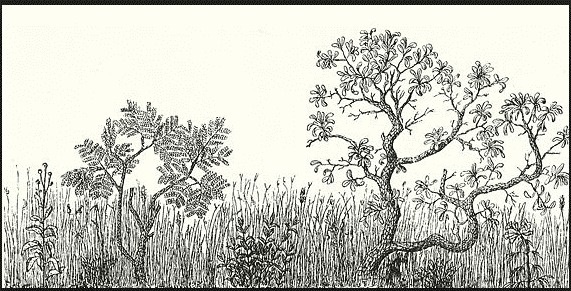
Indeed, in the late nineteenth-century it was in a study of the cerrado that the Danish naturalist Eugenius Warming founded the modern discipline of plant ecology and ecosystems.
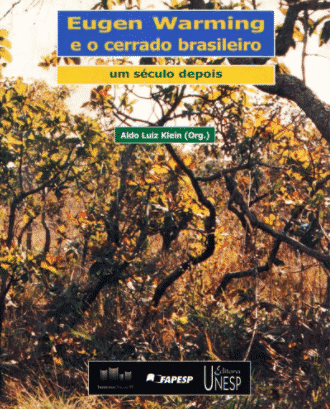
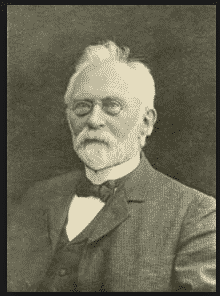
The gnarled and twisted trees with their deep root systems that Warming once studied are now confined to dwindling strips and the occasional local zoo and wildlife reservoir, with corporate sponsorship, of course. Embrapa the agronomists who were the heroes of the Economist’s narrative are now scrambling to devise integrated farming regimes that will sustain the green revolution that they helped to launch.
IV
From Iowa to Brazil by way of global markets for soya and meat, the Gulf of Mexico, aquatic “dead zones” and terrestrial “landscapes of feed” are connected on a hemispheric scale.
As I’m making a cup of tea digesting the way these two stories have melded together, my mind wanders: “So, this is the anthropocene in action, in “real time”. You can follow one of Burger King’s Whoppers and see this entire process unfolding.” But then, when I sit down to write this post that no longer seem quite right:
“The anthropocene in “real time”? What other kind of anthropocene is there? Silly! Once again you are underestimating the radicalism of what is going on. There is nothing but the anthropocene in real time. It doesn’t come any other way. That is the whole point.
Everything, on all scales is happening at once, at astonishing speed. There are fewer and fewer “slow, background processes” against which to contrast the present. There is no longue durée. No, that’s an overstatement. The longue durée retreats. There are fewer domains that belong to one temporality exclusively. The neat ordering of temporalities breaks down. The temporalities into which nature and human affairs are cast are intermingled. And we can no longer count on nature’s patience. The processes unleashed are massive and immediate and happening on a time scale not of millions of years, or millennia, but on the scale on which we normally think about business-cycles, or Schumpeterian growth spurts. With only a bit of time lapse we can watch them unfolding as if on film.
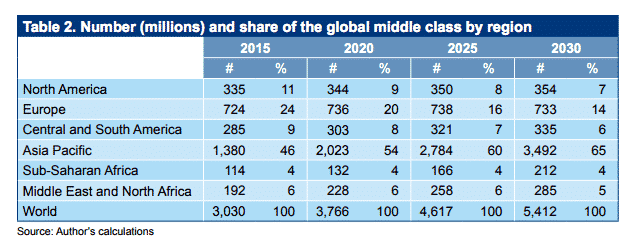
Source: Homi Kharas Brookings 2017
As another jaw-dropping report recently pointed out, we are now entering a phase when the number of people entering middle class affluence globally will hover around 160 million, per annum. The impact of their demand on the world food supply chain will be more spectacular than anything we have seen to date.
We ain’t seen nothing yet.


